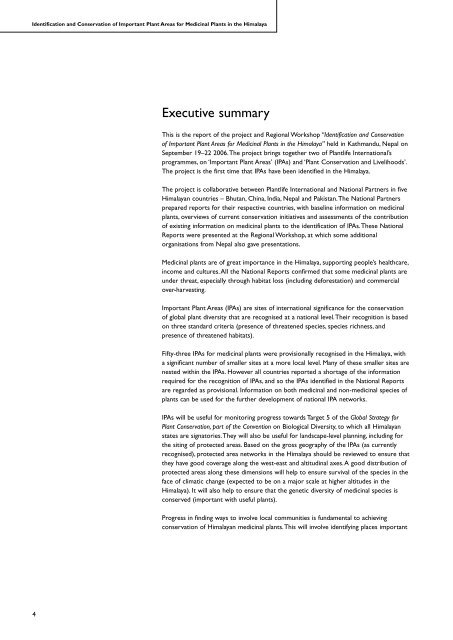Identification and Conservation of Important Plant Areas - Plantlife
Identification and Conservation of Important Plant Areas - Plantlife
Identification and Conservation of Important Plant Areas - Plantlife
- No tags were found...
You also want an ePaper? Increase the reach of your titles
YUMPU automatically turns print PDFs into web optimized ePapers that Google loves.
<strong>Identification</strong> <strong>and</strong> <strong>Conservation</strong> <strong>of</strong> <strong>Important</strong> <strong>Plant</strong> <strong>Areas</strong> for Medicinal <strong>Plant</strong>s in the HimalayaExecutive summaryThis is the report <strong>of</strong> the project <strong>and</strong> Regional Workshop “<strong>Identification</strong> <strong>and</strong> <strong>Conservation</strong><strong>of</strong> <strong>Important</strong> <strong>Plant</strong> <strong>Areas</strong> for Medicinal <strong>Plant</strong>s in the Himalaya” held in Kathm<strong>and</strong>u, Nepal onSeptember 19–22 2006.The project brings together two <strong>of</strong> <strong>Plant</strong>life International’sprogrammes, on ‘<strong>Important</strong> <strong>Plant</strong> <strong>Areas</strong>’ (IPAs) <strong>and</strong> ‘<strong>Plant</strong> <strong>Conservation</strong> <strong>and</strong> Livelihoods’.The project is the first time that IPAs have been identified in the Himalaya.The project is collaborative between <strong>Plant</strong>life International <strong>and</strong> National Partners in fiveHimalayan countries – Bhutan, China, India, Nepal <strong>and</strong> Pakistan.The National Partnersprepared reports for their respective countries, with baseline information on medicinalplants, overviews <strong>of</strong> current conservation initiatives <strong>and</strong> assessments <strong>of</strong> the contribution<strong>of</strong> existing information on medicinal plants to the identification <strong>of</strong> IPAs.These NationalReports were presented at the Regional Workshop, at which some additionalorganisations from Nepal also gave presentations.Medicinal plants are <strong>of</strong> great importance in the Himalaya, supporting people’s healthcare,income <strong>and</strong> cultures.All the National Reports confirmed that some medicinal plants areunder threat, especially through habitat loss (including deforestation) <strong>and</strong> commercialover-harvesting.<strong>Important</strong> <strong>Plant</strong> <strong>Areas</strong> (IPAs) are sites <strong>of</strong> international significance for the conservation<strong>of</strong> global plant diversity that are recognised at a national level.Their recognition is basedon three st<strong>and</strong>ard criteria (presence <strong>of</strong> threatened species, species richness, <strong>and</strong>presence <strong>of</strong> threatened habitats).Fifty-three IPAs for medicinal plants were provisionally recognised in the Himalaya, witha significant number <strong>of</strong> smaller sites at a more local level. Many <strong>of</strong> these smaller sites arenested within the IPAs. However all countries reported a shortage <strong>of</strong> the informationrequired for the recognition <strong>of</strong> IPAs, <strong>and</strong> so the IPAs identified in the National Reportsare regarded as provisional. Information on both medicinal <strong>and</strong> non-medicinal species <strong>of</strong>plants can be used for the further development <strong>of</strong> national IPA networks.IPAs will be useful for monitoring progress towards Target 5 <strong>of</strong> the Global Strategy for<strong>Plant</strong> <strong>Conservation</strong>, part <strong>of</strong> the Convention on Biological Diversity, to which all Himalayanstates are signatories.They will also be useful for l<strong>and</strong>scape-level planning, including forthe siting <strong>of</strong> protected areas. Based on the gross geography <strong>of</strong> the IPAs (as currentlyrecognised), protected area networks in the Himalaya should be reviewed to ensure thatthey have good coverage along the west-east <strong>and</strong> altitudinal axes.A good distribution <strong>of</strong>protected areas along these dimensions will help to ensure survival <strong>of</strong> the species in theface <strong>of</strong> climatic change (expected to be on a major scale at higher altitudes in theHimalaya). It will also help to ensure that the genetic diversity <strong>of</strong> medicinal species isconserved (important with useful plants).Progress in finding ways to involve local communities is fundamental to achievingconservation <strong>of</strong> Himalayan medicinal plants.This will involve identifying places important4
















